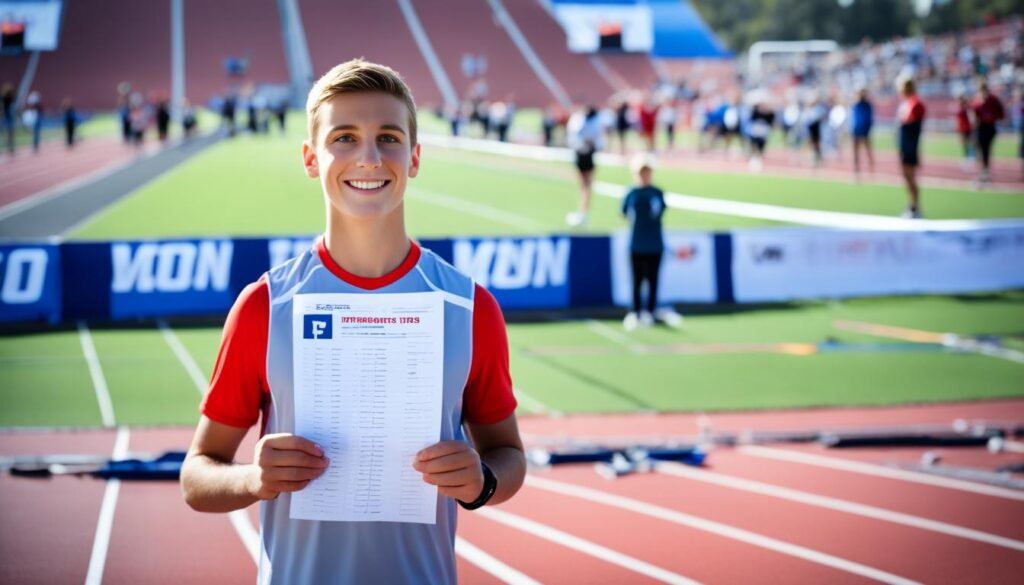Unlock Your Potential: Goal Setting for Athletes

“Set your goals high, and don’t stop till you get there.” – Bo Jackson
Setting goals is an essential aspect of every athlete’s journey. It is the compass that directs their efforts, fuels their motivation, and propels them towards success. Just like Bo Jackson, the legendary athlete who conquered both professional football and baseball, encourages us to set our goals high, athletes must also dare to dream big and push their limits.
Athletes who effectively set goals unlock their true potential by striving for personal bests, relentlessly pursuing improvement, and overcoming obstacles in their path. Whether you’re a young athlete starting your sports journey or an experienced athlete looking to elevate your performance, goal setting can empower you to achieve greatness.
Key Takeaways:
- Setting high goals fuels an athlete’s motivation and drives them towards success.
- Effective goal setting maximizes an athlete’s potential and fosters continuous improvement.
- Daring to dream big means pushing one’s limits and striving for personal bests.
- Goal setting empowers athletes of all levels to achieve greatness in their chosen sport.
- Bo Jackson’s quote serves as a reminder to set ambitious goals and not settle until they are achieved.
The Benefits of Goal Setting for Young Athletes
Setting goals is a crucial aspect of sports performance. Whether you are a young athlete just starting out or aiming to take your game to the next level, goal setting can provide the motivation and focus you need to succeed. By setting clear objectives and working towards them, you can unlock your potential and achieve remarkable results.
When it comes to goal setting in sports, there are two main types of goals: outcome goals and process goals. Understanding and utilizing both types can be beneficial for athletes seeking to maximize their performance.
Outcome goals are geared towards specific results. They focus on the end game and what you ultimately want to achieve. It could be winning a championship, setting a personal record, or securing a spot on a national team. These goals are like beacons that guide your efforts and provide long-term motivation.
Process goals, on the other hand, focus on the steps and actions required to reach your desired outcome. They are the building blocks that contribute to your success. By breaking down your ultimate goal into smaller, manageable steps, you can stay focused on the present moment and make progress towards your larger aspiration.
Both outcome and process goals are essential components of effective goal setting for athletes. They work together to provide balance, direction, and purpose in your athletic journey.
Take a look at the table below for a better understanding of the differences between outcome and process goals:
| Outcome Goals | Process Goals |
|---|---|
| Focus on results | Focus on actions |
| Long-term motivation | Day-to-day motivation |
| Evaluate success based on outcomes | Evaluate success based on effort and progress |
As shown in the table, outcome goals are like the destination on a map, while process goals are the directions to get there. Both types of goals serve a purpose and can help you stay motivated, engaged, and committed throughout your athletic journey.
In the next section, we will explore how outcome-oriented goals can provide long-term motivation for athletes and how process goals can enhance daily training routines.
Setting Outcome-Oriented Goals for Long-Term Motivation
When it comes to goal setting in competitive sports, outcome-oriented goals play a crucial role in keeping athletes motivated and focused on their long-term aspirations. These goals are centered around achieving specific outcomes, such as qualifying for a prestigious competition or accomplishing a significant milestone. By setting SMART goals for athletes, coaches can guide their teams towards long-term success and personal growth.
SMART goals are Specific, Measurable, Achievable, Relevant, and Time-bound. They provide athletes with clear direction and help them stay on track throughout their training journey. Let’s take a closer look at each component of a SMART goal:
- Specific: Goals should be clear and well-defined, leaving no room for ambiguity. Athletes should articulate exactly what they want to achieve.
- Measurable: Goals should be quantifiable, allowing athletes to track their progress and evaluate their performance objectively.
- Achievable: Goals should challenge athletes, but still remain within their reach. Setting realistic goals ensures athletes maintain a positive mindset.
- Relevant: Goals should align with an athlete’s long-term vision and aspirations. They should be meaningful and directly contribute to their overall success.
- Time-bound: Goals should have a specific deadline or time frame attached to them. This creates a sense of urgency and keeps athletes accountable.
By setting outcome-oriented goals that adhere to the SMART criteria, athletes can stay motivated and focused on their journey. These goals serve as a driving force, pushing athletes to reach their full potential.

| Benefits of Outcome-Oriented Goals | Examples |
|---|---|
| 1. Motivation: Outcome-oriented goals provide athletes with a clear target to strive for, keeping them motivated throughout their training. | Qualify for the Olympic Games |
| 2. Focus: These goals help athletes stay focused on the ultimate result they want to achieve, even during challenging times. | Win the national championship |
| 3. Measure of Success: Outcome-oriented goals serve as a tangible measure of an athlete’s progress and success. | Set a personal best in the marathon |
Outcome-oriented goals can inspire athletes to push beyond their limits and achieve extraordinary feats. However, it’s important to strike a balance between setting ambitious goals and maintaining a sense of realism. Unrealistic goals can lead to frustration and disappointment, jeopardizing an athlete’s motivation and self-confidence.
In addition to outcome-oriented goals, it’s crucial for athletes to establish process goals that focus on the day-to-day actions needed to achieve their long-term objectives. This combination of setting outcome-oriented and process goals creates a holistic approach to goal setting in competitive sports.
The Power of Process Goals in Daily Training
When it comes to achieving long-term goals, process goals play a crucial role in an athlete’s training routine. These goals focus on the daily steps and actions that need to be taken to work towards the desired outcome. By setting clear targets for each day, athletes can stay motivated, focused, and ultimately improve their performance in competitive sports.
Process goals provide athletes with a roadmap to success, helping them break down their long-term goals into manageable tasks. By focusing on the process rather than solely fixating on the end result, athletes can reduce mental blocks and enhance their performance. It is this consistent focus on daily progress that can make a significant difference in an athlete’s journey.
For example, imagine a swimmer who has a goal of reducing their lap time by a significant margin. Instead of solely fixating on the end result, they set process goals that include proper warm-up routines, weekly strength training sessions, and incorporating specific drills to improve technique. By setting these daily goals and tracking their progress, the swimmer can stay motivated and make incremental improvements over time.
Process goals also serve as a constant reminder of the athlete’s commitment and dedication to their craft. They provide a sense of purpose and structure to the training routine, ensuring that each day is focused on continuous improvement. Whether it’s completing a certain number of repetitions, increasing weight, or achieving a specific skill, process goals keep athletes engaged and on track.
To illustrate the power of process goals in daily training, here is an example of a swimmer’s daily process goals:
| Process Goals | Action Steps |
|---|---|
| Improve Technique | Complete 10 minutes of technique-focused drills at the beginning of each practice. |
| Build Endurance | Incorporate interval training sets to gradually increase the distance covered in each session. |
| Increase Speed | Include sprint sets to enhance speed and power in the water. |
| Maintain Consistency | Attend all scheduled training sessions without skipping or compromising on effort. |
By following these process goals consistently, the swimmer can gradually improve their lap time and work towards their long-term goal. Each action step contributes to their overall progress, building a solid foundation for success.

Throughout an athlete’s journey, process goals provide the necessary direction and focus to consistently move forward. By incorporating these goals into daily training routines, athletes can overcome obstacles, sharpen their skills, and ultimately achieve their desired outcomes in competitive sports.
The Goal Setting Technique for Young Athletes
For young athletes, mastering the art of goal setting is essential in their journey towards success in sports. By adopting a specific technique that combines both outcome-oriented goals and process goals, athletes can stay focused, motivated, and on track to achieve their long-term goals.
Outcome-Oriented Goals:
Outcome-oriented goals are the overarching objectives that athletes strive to achieve. These goals are measurable and provide a clear vision of the desired outcome. For example, a young soccer player may set a goal to score a certain number of goals in a season or make it onto a higher-level team.
Process Goals:
Process goals, on the other hand, focus on the specific actions and steps that athletes need to take on a daily and weekly basis to reach their outcome-oriented goals. These goals break down the larger goal into smaller, manageable tasks and create a roadmap for success. Process goals for our young soccer player could include practicing specific skills, attending extra training sessions, or improving fitness levels.
By combining both types of goals, young athletes create a comprehensive goal-setting strategy that encompasses their long-term aspirations and the tangible actions required to achieve them. Here’s an example of how this technique may be applied:
The Goal Setting Technique in Action:
Outcome-Oriented Goal: Qualify for the State Championship
Process Goals:
- Practice shooting accuracy for 30 minutes every day
- Attend team training sessions consistently
- Improve speed and agility through daily conditioning exercises
- Study game strategies and tactics weekly
By setting specific, measurable process goals that align with their outcome-oriented goal, young athletes can track their progress, remain motivated, and make steady advancements towards their ultimate target. Breaking the goals into smaller, achievable tasks enhances focus and prevents overwhelming feelings that can hinder performance.
Remember, the key to effective goal setting for young athletes is finding the right balance between challenging yet attainable goals. The goals should push them outside of their comfort zone and inspire growth, but they should also be realistic and within their capabilities.
Now that you understand the goal setting technique for young athletes, it’s time to put it into practice. Set your sights on your big dreams, break them down into achievable steps, and watch as you progress towards your desired outcomes in the world of sports.

Guidelines for Effective Goal Setting
Setting goals is a crucial aspect of an athlete’s journey towards unlocking their full potential. To ensure that your goals are effective and drive you towards success, here are some essential guidelines to follow:
1. Make your goals challenging yet achievable
When setting goals, it is important to strike a balance between ambition and achievability. Setting overly easy goals won’t push you to grow, while setting goals that are too difficult may lead to frustration. Find the sweet spot that challenges you but is within your reach, pushing you to give your best.
2. Be specific and measurable
Ambiguity can hinder progress, so make sure your goals are specific and measurable. Define what you want to achieve and set clear metrics to track your progress. This will make it easier to assess your performance and make the necessary adjustments along the way.
3. Focus on your own performance and process
While outcome-oriented goals can be motivating, it is essential to prioritize your own performance and process. By focusing on the daily actions and habits that contribute to your success, you can maintain consistency and develop the necessary skills and mindset to achieve your desired outcomes.

4. Take ownership of your goals
Your goals should reflect your values, aspirations, and personal growth. Take ownership of your goals by aligning them with your vision and purpose. This sense of ownership will drive your motivation, commitment, and determination to overcome challenges along the way.
5. Seek support from your circle of influence
Building a strong support system is crucial in your goal-setting journey. Surround yourself with individuals who believe in you, motivate you, and hold you accountable. Seek guidance from coaches, mentors, teammates, and loved ones who will inspire and support you throughout your athletic endeavors.
By following these guidelines, you can set effective goals that propel you towards success, strengthen your mental resilience, and maximize your potential as an athlete.
Conclusion
Goal setting is a powerful tool for athletes to unlock their potential and achieve success. By setting big, scary goals, athletes can push themselves to overcome obstacles and reach new levels of performance. Whether it’s qualifying for a specific competition or achieving a personal best, having a goal gives athletes something to strive for and a clear direction to follow.
However, setting the right goals is just the beginning. Athletes should also focus on the process, the daily steps and actions required to achieve those goals. By breaking down big goals into smaller, manageable tasks, athletes can stay motivated and see progress every step of the way. Process goals provide the structure and focus needed to make consistent improvements.
To make goal setting even more effective, it’s essential to embrace discomfort. Stepping out of your comfort zone is where growth happens. Set goals that scare you a little, that challenge your abilities and push you to the edge of your limits. These are the goals that will truly unlock your potential and propel you forward.
Finally, surround yourself with positive influences. Seek support from coaches, teammates, and mentors who believe in you and encourage your goals. Their guidance and encouragement can make a significant difference in your journey. With passion and determination, and the right goal setting strategies, you can chase your dreams and achieve greatness in your athletic pursuits.






